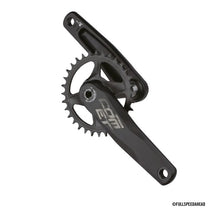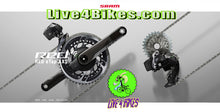Unleash Your Inner Trailblazer with the FSA Comet Press-In 1x Crankset
When it comes to conquering the rugged terrains of mountain biking, having a reliable and high-performance crankset is crucial. The FSA Comet Press-In 1x Crankset is a game-changing component that caters to the needs of dedicated mountain bikers. In this article, we will explore the remarkable features and specifications of the FSA Comet Crankset and understand why it's an excellent choice for off-road adventures.
FSA Comet Press-In 1x Crankset: Key Specifications
Type: Cranksets
Technology: MegaExo, Megatooth, Modular
Discipline: MTB (Mountain Bike)
Series: COMET
Color: Black
Compatibility: MegaExo
Bolt Circle Diameter (BCD): DIRECT MOUNT
Crankset Type: Single
Drivetrain Compatibility: Shimano 11/12S, Sram 11/12S
Length: 170mm; 175mm
Material: Alloy
In-Depth Look at the FSA Comet Crankset
-
Cutting-Edge Technology:
The FSA Comet Crankset incorporates advanced technologies, including MegaExo, Megatooth, and Modular design. MegaExo technology ensures a robust and reliable bottom bracket interface, offering improved power transfer and durability. The Megatooth feature enhances chain retention and reduces the risk of drops, ensuring a more secure ride. The Modular design allows for easy chainring swaps, giving riders the flexibility to customize their drivetrain to meet their specific needs.
-
Mountain Biking Excellence:
Designed for off-road enthusiasts, the FSA Comet Crankset is part of the COMET series, making it a natural fit for mountain biking disciplines. Whether you're conquering rocky trails or powering through muddy paths, this crankset is engineered to meet the demands of MTB riders, offering the performance and reliability required to tackle challenging terrains.
-
Sleek and Bold:
The black color of the FSA Comet Crankset not only adds a touch of elegance to your bike but also ensures that it can withstand the inevitable wear and tear of off-road adventures. Its durable finish keeps it looking great even after extensive use, making it a long-lasting addition to your mountain bike.
-
Versatile Compatibility:
The FSA Comet Crankset boasts a DIRECT MOUNT Bolt Circle Diameter (BCD), allowing it to accommodate various chainring sizes and configurations. Its single crankset design simplifies the drivetrain and optimizes performance. It offers compatibility with both Shimano and SRAM drivetrains, making it adaptable to a wide range of setups.
-
Built for Endurance:
Crafted from alloy, the FSA Comet Crankset strikes an ideal balance between strength and weight. This material choice ensures that the crankset can handle the rigors of mountain biking while keeping the overall weight of your bike manageable. The available lengths of 170mm and 175mm cater to different rider preferences and body types.
Why Choose the FSA Comet Crankset from Live4Bike
When it comes to purchasing bike components, the source plays a pivotal role in ensuring you get the best product and service. Live4Bike stands out as a preferred choice for several reasons:
-
Quality Assurance:
Live4Bike offers products from reputable brands like FSA, assuring you of high-quality components that meet industry standards. The FSA Comet Crankset is a testament to the brand's commitment to quality and innovation.
-
Expertise:
The team at Live4Bike possesses extensive knowledge of cycling components, allowing them to provide you with valuable guidance and advice to help you make the right choices for your bike.
-
Wide Selection:
Live4Bike offers a comprehensive range of cycling products, ensuring you can find everything you need in one place, simplifying your shopping experience.
-
Customer Service:
Live4Bike prides itself on excellent customer service, providing support throughout your purchase and addressing any concerns you may have.
Conclusion
The FSA Comet Press-In 1x Crankset is a standout choice for mountain biking enthusiasts seeking a combination of advanced technology, rugged durability, and versatile compatibility. When you purchase this exceptional crankset from a reputable source like Live4Bike, you can be confident that you are receiving a quality product backed by outstanding customer service. Elevate your off-road adventures and blaze new trails with the FSA Comet Crankset, designed to meet the demands of the modern mountain biker.
- More Crank info
- DIY TIPS
- Minimize Windows
Understanding Bicycle Cranks: Types, Sizes, and Materials
Introduction
Bicycle cranks are a crucial component of a bike's drivetrain, responsible for transferring the rider's pedaling force to the chainring, which in turn propels the bicycle forward. In this article, we'll explore the various types of bicycle cranks, different sizes available, and the materials they are constructed from.
Types of Bicycle Cranks
-
Square Taper Cranks:
Square taper cranks are a traditional design, characterized by a square-shaped spindle that fits into the bottom bracket. They have been a standard for many years, known for their simplicity and durability. However, they are becoming less common with the rise of newer technologies.
-
Octalink Cranks:
Shimano introduced the Octalink system, which features eight splines on the crank arm that interface with a matching bottom bracket. Octalink cranks are known for their increased stiffness and power transfer compared to square taper cranks.
-
ISIS Drive Cranks:
ISIS (International Splined Interface Standard) drive cranks use a splined interface between the crank arm and the bottom bracket spindle. This design was intended to improve stiffness and durability, but it has been largely replaced by newer standards.
-
External Bearing Cranks:
External bearing cranks, also known as Hollowtech II (by Shimano) or GXP (by SRAM), use outboard bearings that sit outside of the bottom bracket shell. This design provides increased stiffness and weight savings.
-
Direct Mount Cranks:
Direct mount cranks have become popular in recent years, especially in the mountain biking community. They attach directly to the spindle, eliminating the need for a separate chainring spider. This design allows for a wider range of chainring sizes and improved stiffness.
Different Sizes of Bicycle Cranks
-
Crank Arm Length:
Crank arm length is measured from the center of the bottom bracket spindle to the center of the pedal spindle. Common lengths range from 165mm to 180mm. Shorter crank arms can provide a more aerodynamic position and are favored by some cyclists, while longer crank arms may offer more leverage for powerful pedaling.
-
Chainring Sizes:
The size of the chainring(s) on the crankset can significantly affect the bike's gearing. Smaller chainrings provide easier pedaling but lower top speeds, while larger chainrings offer higher top speeds but require more effort to pedal.
Materials Used in Bicycle Cranks
-
Aluminum:
Aluminum cranks are lightweight, relatively inexpensive, and offer good stiffness. They are popular in entry-level and mid-range bicycles.
-
Carbon Fiber:
Carbon fiber cranks are known for their exceptional strength-to-weight ratio. They offer excellent stiffness and can help reduce overall weight, making them popular among high-end and performance-oriented cyclists.
-
Steel:
Steel cranks are durable and cost-effective but tend to be heavier than aluminum or carbon fiber options. They are commonly found on budget-friendly and commuter-oriented bikes.
-
Titanium:
Titanium cranks strike a balance between weight, strength, and durability. They are relatively lightweight and offer excellent corrosion resistance, making them a premium choice for some cyclists.
Conclusion
Choosing the right bicycle crank is essential for optimizing your riding experience. Consider factors like the type of riding you'll be doing, your personal preferences, and your budget when selecting a crankset. Understanding the different types, sizes, and materials available will help you make an informed decision that suits your specific cycling needs.
```Comprehensive Guide to Removing a Square Taper Bicycle Crank
Tools Needed:
- Crank puller tool (compatible with square taper cranks)
- Allen wrench or socket wrench set
- Bottom bracket tool (if necessary)
- Grease (optional)
- Rag or cloth (to clean and wipe parts)
Step-by-Step Guide:
-
Prepare Your Workspace:
Start by finding a clean, well-lit area to work. Lay down a rag or cloth to catch any dirt or small parts that may fall.
-
Gather Tools:
Ensure you have all the necessary tools listed above.
-
Prepare the Bike:
If you have a derailleur, shift the chain onto the smallest chainring to provide easier access to the crankset. If you have a single-speed or fixed-gear bike, you don't need to worry about this step.
-
Remove the Crank Bolts:
Use an Allen wrench or socket wrench to loosen and remove the bolts that hold the crank arms onto the bottom bracket spindle. There are usually two bolts, one on each side.
-
Use the Crank Puller:
Insert the inner part of the crank puller tool into the bottom bracket spindle. Make sure it's threaded securely. Then, thread the outer part of the tool into the crank arm threads. Tighten the outer part of the crank puller tool until the crank arm starts to come off the spindle.
-
Remove the Crank Arm:
Continue to turn the crank puller until the crank arm comes off the spindle. Be sure to support the crank arm with your hand as it comes free to avoid it falling and potentially damaging the ground or other components.
-
Repeat for the Other Side:
If you're removing both crank arms, repeat steps 4-6 for the other side.
-
Inspect and Clean:
Take this opportunity to inspect the bottom bracket and crankset for any signs of wear or damage. Clean the spindle and bottom bracket shell if necessary.
-
Reassembly (if needed):
If you're replacing the crankset or performing maintenance, this is the time to install the new one. Apply a thin layer of grease to the square taper interface before attaching the new crank arms.
-
Tighten Everything Securely:
Ensure that all bolts and nuts are properly tightened to the manufacturer's specifications. Over-tightening can cause damage, so use a torque wrench if available.
-
Test the Crankset:
Spin the crankset to ensure there's no wobbling or unusual resistance. Check that the chain moves smoothly across the chainrings.
Remember to always refer to your specific bike's manufacturer recommendations and specifications, as there may be slight variations in the process depending on the make and model. If you're unsure or uncomfortable with any step, consider seeking help from a professional bike mechanic.




